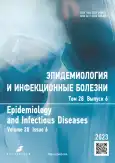Malignant anthrax in Russian Federation in 2023: two case reports
- Authors: Nikiforov V.V.1, Sorokina N.A.2
-
Affiliations:
- Russian National Research Medical University named after N.I. Pirogova
- Voronezh City Clinical Emergency Hospital No. 8
- Issue: Vol 28, No 6 (2023)
- Pages: 387-400
- Section: CASE REPORTS
- URL: https://journals.rcsi.science/1560-9529/article/view/251347
- DOI: https://doi.org/10.17816/EID623060
- ID: 251347
Cite item
Abstract
Malignant anthrax is a serious health and agricultural problem in Russia. Since 1900, >70,000 outbreaks of infection among people and animals have been reported in Russia. Adequate veterinary measures have led to a decrease in the level of morbidity in livestock, which is the main causative agent. Moreover, the incidence of human illness has decreased, which is greatly facilitated by routine immunization of the population exposed to occupational risk of infection. However, despite the measures taken, epizootics and epidemic foci of anthrax are registered annually. As a result, anthrax occur often among residents of these areas.
This study discusses the modern course of the cutaneous form of anthrax, which was analyzed during the treatment of patients from two foci of anthrax infection in the Voronezh region in August–October 2023. The novelty of this observation lies in the opportunity to present to readers the evolution of skin changes in the carbunculus variety of cutaneous anthrax from the early stages of ulcerative process development to almost complete recovery.
Full Text
##article.viewOnOriginalSite##About the authors
Vladimir V. Nikiforov
Russian National Research Medical University named after N.I. Pirogova
Author for correspondence.
Email: v.v.nikiforov@gmail.com
ORCID iD: 0000-0002-2205-9674
SPIN-code: 9044-5289
MD, Dr. Sci. (Med), Professor
Russian Federation, MoscowNatalia A. Sorokina
Voronezh City Clinical Emergency Hospital No. 8
Email: vishenka.79@bk.ru
ORCID iD: 0009-0000-4757-2792
Russian Federation, Voronezh
References
- Popova AYu, Ezhlova EB, Demina YuV, et al. Ways to improve the epidemiological surveillance and control of anthrax in the Russian Federation. Problemy Osobo Opasnykh Infektsii. 2017;(1):84–88. (In Russ). doi: 10.21055/0370-1069-2017-1-84-88
- Shakhmardanov MZ, Abusuevа AS, Nikiforov VV, Tomilin YN, Burova SV. Anthrax in Dagestan: clinical and epidemiological characteristics, risks, and prognosis of a group outbreak in 2019. Epidemiology and Infectious Diseases. 2019;24(5–6):213–219. (In Russ). doi: 10.17816/EID34791
- Ryazanova AG, Skudareva ON, Gerasimenko DK, et al. Analysis of the situation on anthrax in the world in 2022, the forecast for the Russian Federation for 2023. Problemy Osobo Opasnykh Infektsii. 2023;(2):84–94. (In Russ). doi: 10.21055/0370-1069-2023-2-88-94
- Anthrax. World Organization for Animal Health [Internet]. Available at: https://wahis. woah.org/#/in-review/4647?reportId=157426&fromPage=event-dashboard-url.
- Foreign epidemiological review — Anthrax (human infection, 2 cases) — USA (Colorado (2) [Internet]. 17 Aug. 2022. Archive Number: 20220817.8705080. Available at: http://promedmail.promedmail.org/ru.
- V 2023 godu na territorii Rossijskoj Federacii nabljudaetsja rezkoe obostrenie jepizooticheskoj situacii po sibirskoj jazve. Administracija gorodskogo okruga Chehov. (In Russ). Available at: https://chekhov.mosreg.ru/article/v-2023-godu-na-territorii-rossijskoj-federatsii-nablyudaetsya-rezkoe-obostrenie-epizooticheskoj-situatsii-po-sibirskoj-yazve-487967.
- Vasil’ev KG, Segal AE. Istorija jepidemij v Rossii. Metelkina AI, editor. Moscow: Medriz; 1960. (In Russ).
- Central’nyj gosudarstvennyj arhiv drevnih aktov. Portfeli Millera N 150 (1763). I PSZ. XVI. N 12032. (In Russ).
- Cherkasskij BL. Jepidemiologija i profilaktika sibirskoj jazvy. Moscow: Intersjen; 2002. (In Russ).
- Rudnev GP. Klinika osobo opasnyh infekcij. Moscow: Medicina; 1966. (In Russ).
- Rozenberg NK. Infekcionnye bolezni s osnovami chastnoj jepidemiologii. Leningrad: Medgiz, Leningr. otd-nie; 1938. (In Russ).
- Burgasov PN, Rozhkov GI. Sibirejazvennaja infekcija. Moscow: Medicina; 1984. (In Russ).
- Nikiforov VN. Kozhnaja forma sibirskoj jazvy cheloveka. Moscow: Medicina; 1973. (In Russ).
- Enaux M, Chaussier F. Méthode de traiter les morsure des animaux enragės et de la vipere; suivie d’un précis sur la pustule maligne. Dijon; 1785. (In French).
- Beloglazov MM. O sibirskoj jazve u cheloveka. Moscow: Tipolitografija A. V. Vasil’eva i K; 1901. (In Russ).
- Rozen’er LA. Sibirskaja jazva u cheloveka. Kishinev; 1948. (In Russ).
- Voiculescu M. Boli contagioase. Bucuresti; 1955. (In Romanian).
- Rudnev GP. Zoonozy. Moscow: Medgiz; 1959. (In Russ).
- Shljahov JeN. Sibirskaja jazva. In: Sanitarno-jepidemiologicheskaja stancija: organizacionno-metodicheskie materialy. Moscow: Medgiz; 1955. P:261. (In Russ).
- Ioakmis KD. Diagnostika i lechenie sibirskoj jazvy. Sovetskoe zdravoohranenie Kirgizii. 1941;(5–6):85. (In Russ).
- Bourgeois I. Traite pratique de la pustole maligne et de l, oedeme malinches l, homme. Paris, 1861. (In French).
- Koranyi Fr. Der Milsbrand. Handb. d. allg. und spec. Chir. Bd. 1, Abt. 2. H. 1. Lief 3 Pitha u Billroth. Erlang; 1870. (In German).
- Ivanovskij AV. Sibirskaja jazva na kozhevennyh i shubno-ovchinnyh zavodah. Vestnik obshhestvennoj gigieny. 1894;(21):2. (In Russ).
- Lintvarev SI. K voprosu ob jetiologii sibirskoj jazvy u cheloveka. Vrachebnaja gazeta. 1903;(36–37):16. (In Russ).
- Reznikov AV. Dva sluchaja sibirskoj jazvy, ustanovlennye bakteriologicheski. Vrach. delor. 1924;(6):292. (In Russ).
- Korytin-Novikov LE. Sluchaj obshirnogo sibirejazvennogo otjoka s soputstvujushhim porazheniem kishechnika. Vestnik hirurgii. 1933;29(85–86):162. (In Russ).
- Bogdanov P. O karbunkuleznyh boleznjah [dissertation]. Moscow, 1863. (In Russ).
- Spinola WThI. Handbuch der speciellen Pathologie und Therapie fur Thireurste. Bd. 1–4. Berlin: Verlag von August Hirschwald.; 1855–1863. (In German).
- Ljubimov P. O sibirskoj jazve na ljudjah [dissertation]. Saint Petersburg; 1867. (In Russ).
Supplementary files






















